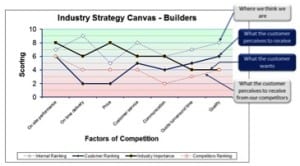Marketing Strategy and Objectives
Business Marketing Strategy Statement
Once the analysis part of your business marketing strategy planning is complete, the key requirement is to articulate your overall marketing strategy. In other words, what is the overall marketing direction that will be taken in order to reach your business goals? Most importantly, the strategy statement will take into account what you have recognised as your sustainable competitive advantage and the value proposition that you will offer to the market.
Typically, a B2B marketing strategy statement will define the positioning of the business by addressing things such as whether the aim is to be a high quality / high value player; lowest cost, high volume; full service provider; specialist niche or other factors.
Business Marketing Objectives
In order to implement an effective marketing plan, you need to define exactly what you are trying to achieve. The reason that a lot of SMEs waste money is that their marketing efforts are a collection of ad hoc initiatives with no plan or structure behind what they are trying to achieve. Once you have defined what it is that you wish to achieve, it is relatively straightforward to determine whether or not an activity or initiative will take you towards your goal.
Your objectives should include an indication of the quantum of sales revenue that the marketing effort needs to support. You can construct a marketing plan that will increase sales by $1 million or $10 million, the difference will be the resource level required to implement it. The other aspect of having a quantified goal is that it will tell you whether or not you need to enter new markets.
In our role as business consultants, we often find businesses turning over $10 million that want to grow to $12.5 million over three years in a very large (say $500 million plus) market. They are considering introducing new products, setting up interstate or attacking the export market. While all of these things are laudable, the reality in many cases is that the desired growth can be achieved by better farming of the home paddock, which is known territory and will be the lowest cost option.
In B2B markets that have a large number of potential customers, the strategic objectives will usually include a statement about creating an awareness level amongst a community of potential buyers who will find you when they are ready to buy. This is what will drive your social media strategy, which these days is an essential part of how you communicate with your customers.
Some typical B2B marketing objectives:
- Build revenue to $12 million per annum within 3 years.
- Position the business as the industry specialist that meets all Australian Standards requirements and has compliant HSEQ systems.
- Increase awareness amongst potential customers of the one stop shop offer.
- Position the business as the clear choice, number two supplier to the market leader in Queensland.
- Diversify the customer base such that no single client represents more than 20% of revenue.
- Generate sufficient business to support a separate Service and Maintenance Department.
- Position the business as the low risk supplier of choice in the target market.
Once you have articulated your business marketing strategy statement and defined well researched, specific and achievable marketing objectives (perhaps with the assistance of an experienced business consultant?), your B2B marketing strategy is well on its way to being successfully implemented to achieve your business objectives.

